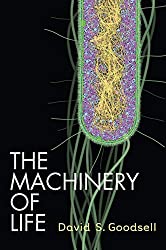
Rating: 8.1/10.
A fairly unique book that explains molecular biology using illustrations and detailed to-scale 3D renderings of molecules. Only about 150 pages but there’s an illustration on nearly every page, explaining many different cellular processes, such as: DNA transcription, cellular respiration, breakdown of an E. coli bacterium, viruses, drugs. Doesn’t go too deep into any topic but covers a good breadth of cell functions.
I won’t review any of the specific processes in detail, just the overall impression. The cell is actually very dense, with thousands of molecules bumping into each other randomly, but small enough that any two molecules that have an affinity for each other will quickly find each other. Proteins are little molecular machines that fold into all sorts of shapes, each one has a specific function, like attach a phosphate group to a molecule, or cut DNA when a certain pattern is detected.
What’s amazing is that all this diversity comes from combinations of 20 amino acids (which are coded by 4 nucleotides). Even in a single-celled bacterium, these molecular machines have to work together to achieve all the functions of life: synthesizing proteins, copying DNA, absorbing nutrients, converting them into energy, defending against threats, etc. Our human medicines are primitive in comparison and only target one protein at a time to get it to do something different.
Often the comparison is made between DNA and machine code, but DNA is harder, it only tells you the shape of the protein (assuming you’ve solved protein folding). This book makes me appreciate the thousands of hours of lab work to figure out what each protein is doing.



